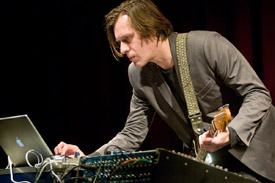
The region’s premier experimental music showcase returns this week for a solid mix of noise, ambient and other experimental music.
Now in its ninth year, the Sonic Circuits Festival will be held in venues across the Washington area. It includes a diverse group of venues, from The Fridge, an art gallery/performance space near the Eastern Market, to places such as the Kennedy Center (where shows at its Millennium Stage are free) and the French Embassy, all for one week of celebrating the different on a local, national and international level.
Saturday’s opening at the La Maison Française in Washington already featured a compilation of styles, from the free-jazz styling of Vector Trio to psych-pop outfit Hume. The night ended with a performance from Magma, the obscure French group whose 1969 self-titled double LP debut, also known as Kobaïa, was conceived around future space colonization.
Yesterday featured 12 hours of music at Fairfax’s Old Town Hall, including a line-up of everything from, according to festival director Jeff Surak, “Chamber music with robots, art damaged post punk, hip hop, free jazz, drone, etc. … all with an experimental focus.”
Talent-wise, Sonic Circuits is something of a regional affair, as most of the artists are from Washington or somewhere along the East Coast. But as Surak points out, the Washington experimental scene is a diverse community of musicians.
“It cuts across genres and age groups,” Surak said. “People who perform free improv and jazz play with those making harsh noise or drone music. Academically trained musicians play with lo-fi, untrained artists. Retirees play with teenagers. There are no music cliques, everyone is super supportive and collaboration and sharing of ideas are part of the culture.”
For Takoma Park resident Jason Mullinax, the man behind festival-opener Pilesar, the festival, along with some of the events Sonic Circuits puts on year-round, have an almost workshop feel to them.
Mullinax agrees with Surak’s view on the local experimental scene.
“I think it’s a very free and open community,” he said.
Mullinax said commercial aspirations in the District are nil for a lot of experimental musicians, though he hopes to tour a little behind his upcoming album. The priority is the music, leading to a “free and open” community. His own website for Pilesar features over 30 recordings, free for download.
“The biggest challenge is always funding,” Surak said. “Experimental music is not something that readily comes to mind for many venues or arts institutions, as they tend to stick to more commercial and light forms of music.”
Tuesday’s Strathmore show may do the best job reaching out to the uninitiated. The opener, Low End String Quartet, rearranges the traditional string quartet to include two basses and an electric guitar. Later, Austria’s Fennesz closes the night with his ethereal arrangements on guitar.
“Over time, some aspects of organizing the festival have gotten easier,” Surak said. “As its reputation as top-notch presenter of cutting edge music has spread, more places have offered their support, such as venues.”
“I love sound in general,” Mullinax said in an offhanded remark, which perhaps epitomizes pure experimental ethos. With Mullinax and much of the Sonic Circuits performers, music is all about textures and patterns, not ringtones or Auto-Tune.
The Sonic Circuits Festival runs from Sept. 18 to Sept. 25 at various venues in the area. For more information, visit www.dc-soniccircuits.com.
diversions@umdbk.com



